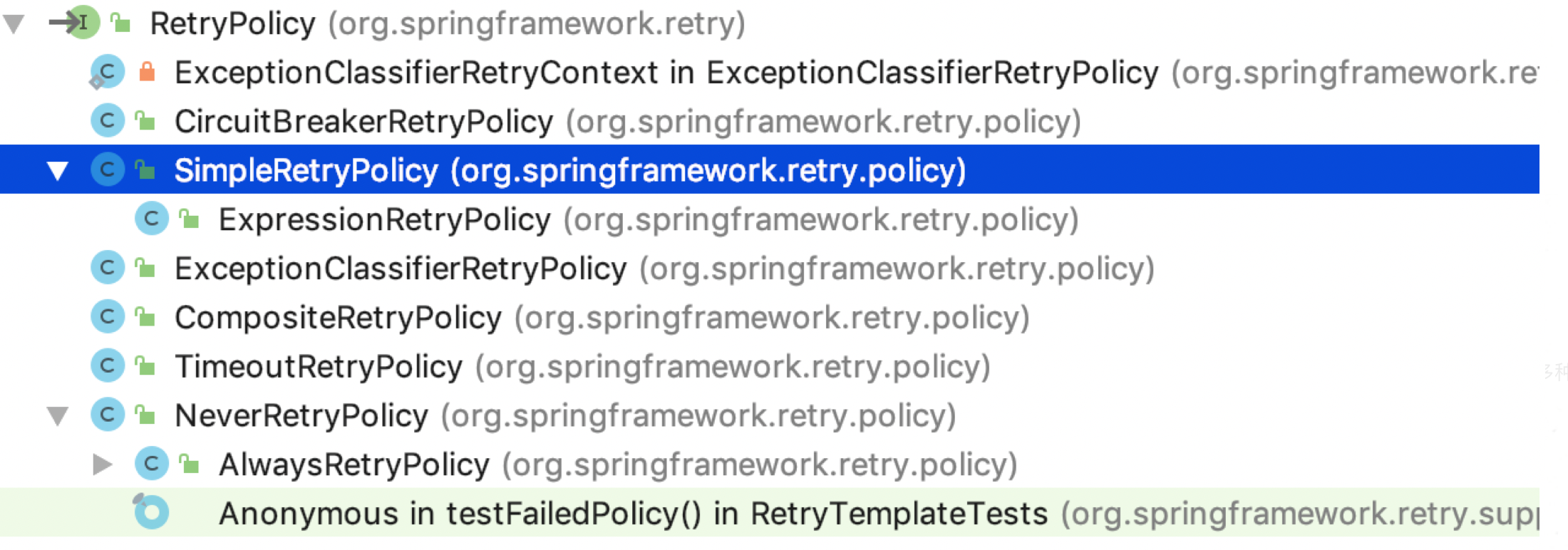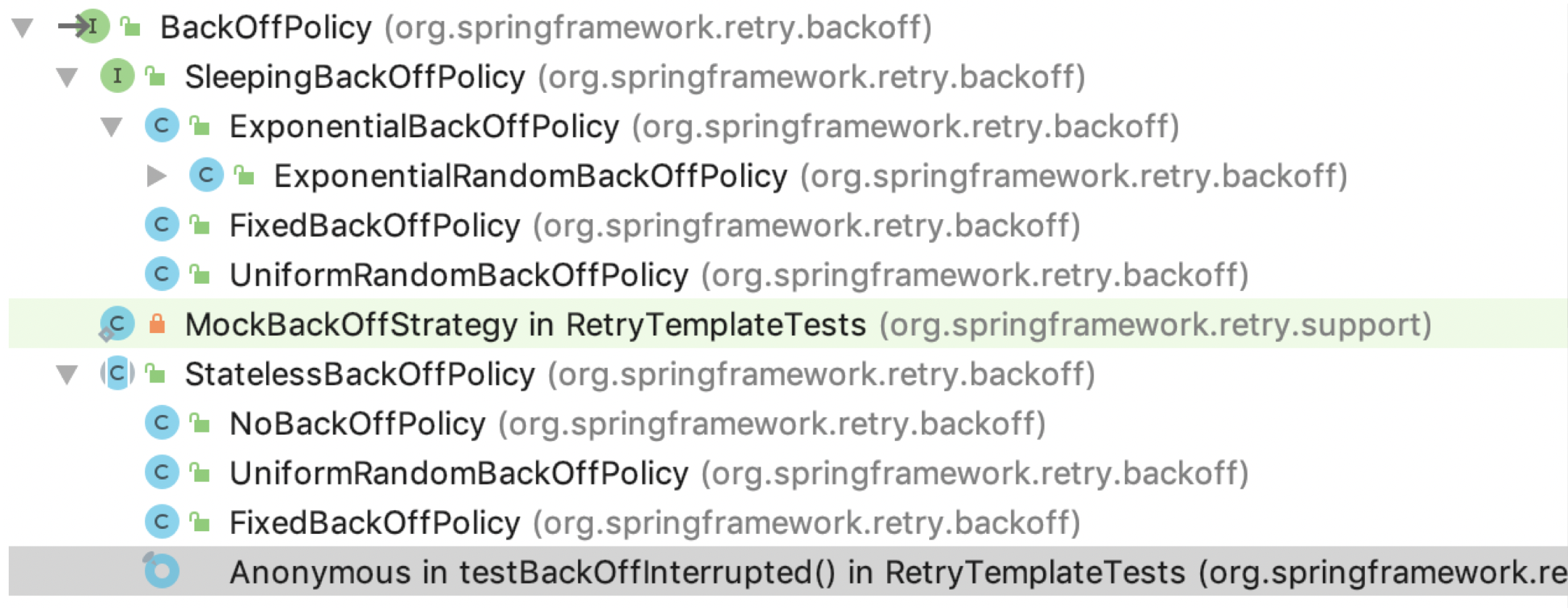概要
Spring实现了一套重试机制,功能简单实用。Spring Retry是从Spring Batch独立出来的一个功能,已经广泛应用于Spring Batch,Spring Integration, Spring for Apache Hadoop等Spring项目。
本文将讲述如何使用Spring Retry及其实现原理。
背景
重试,其实我们其实很多时候都需要的,为了保证容错性,可用性,一致性等。一般用来应对外部系统的一些不可预料的返回、异常等,特别是网络延迟,中断等情况。还有在现在流行的微服务治理框架中,通常都有自己的重试与超时配置,比如dubbo可以设置retries=1,timeout=500调用失败只重试1次,超过500ms调用仍未返回则调用失败。
如果我们要做重试,要为特定的某个操作做重试功能,则要硬编码,大概逻辑基本都是写个循环,根据返回或异常,计数失败次数,然后设定退出条件。 这样做,且不说每个操作都要写这种类似的代码,而且重试逻辑和业务逻辑混在一起,给维护和扩展带来了麻烦。
从面向对象的角度来看,我们应该把重试的代码独立出来。
使用介绍
基本使用
先举个例子:
1 |
|
@EnableRetry - 表示开启重试机制
@Retryable - 表示这个方法需要重试,它有很丰富的参数,可以满足你对重试的需求
@Backoff - 表示重试中的退避策略
@Recover - 兜底方法,即多次重试后还是失败就会执行这个方法
Spring-Retry 的功能丰富在于其重试策略和退避策略,还有兜底,监听器等操作。
然后每个注解里面的参数,都是很简单的,大家看一下就知道是什么意思,怎么用了,我就不多讲了。
重试策略
看一下Spring Retry自带的一些重试策略,主要是用来判断当方法调用异常时是否需要重试。(下文原理部分会深入分析实现)

- SimpleRetryPolicy
默认最多重试3次 - TimeoutRetryPolicy
默认在1秒内失败都会重试 - ExpressionRetryPolicy
符合表达式就会重试 - CircuitBreakerRetryPolicy
增加了熔断的机制,如果不在熔断状态,则允许重试 - CompositeRetryPolicy
可以组合多个重试策略 - NeverRetryPolicy
从不重试(也是一种重试策略哈) - AlwaysRetryPolicy
总是重试
….等等
退避策略
看一下退避策略,退避是指怎么去做下一次的重试,在这里其实就是等待多长时间。(下文原理部分会深入分析实现)

- FixedBackOffPolicy
默认固定延迟1秒后执行下一次重试 - ExponentialBackOffPolicy
指数递增延迟执行重试,默认初始0.1秒,系数是2,那么下次延迟0.2秒,再下次就是延迟0.4秒,如此类推,最大30秒。 - ExponentialRandomBackOffPolicy
在上面那个策略上增加随机性 - UniformRandomBackOffPolicy
这个跟上面的区别就是,上面的延迟会不停递增,这个只会在固定的区间随机 - StatelessBackOffPolicy
这个说明是无状态的,所谓无状态就是对上次的退避无感知,从它下面的子类也能看出来
原理
原理部分我想分开两部分来讲,一是重试机制的切入点,即它是如何使得你的代码实现重试功能的;二是重试机制的详细,包括重试的逻辑以及重试策略和退避策略的实现。
切入点
@EnableRetry
1 | (ElementType.TYPE) |
我们可以看到@EnableAspectJAutoProxy(proxyTargetClass = false)
这个并不陌生,就是打开Spring AOP功能。
重点看看@Import(RetryConfiguration.class)
@Import相当于注册这个Bean
我们看看这个RetryConfiguration是个什么东西
它是一个AbstractPointcutAdvisor,它有一个pointcut和一个advice。我们知道,在IOC过程中会根据PointcutAdvisor类来对Bean进行Pointcut的过滤,然后生成对应的AOP代理类,用advice来加强处理。
看看RetryConfiguration的初始化:
1 |
|
1 | protected Pointcut buildPointcut(Set<Class<? extends Annotation>> retryAnnotationTypes) { |
上面代码用到了AnnotationClassOrMethodPointcut,其实它最终还是用到了AnnotationMethodMatcher来根据注解进行切入点的过滤。这里就是@Retryable注解了。
1 | //创建advice对象,即拦截器 |
AnnotationAwareRetryOperationsInterceptor
继承关系
可以看出AnnotationAwareRetryOperationsInterceptor是一个MethodInterceptor,在创建AOP代理过程中如果目标方法符合pointcut的规则,它就会加到interceptor列表中,然后做增强,我们看看invoke方法做了什么增强。
1 |
|
这里用到了委托,主要是需要根据配置委托给具体“有状态”的interceptor还是“无状态”的interceptor。
1 | private MethodInterceptor getDelegate(Object target, Method method) { |
getStatefulInterceptor和getStatelessInterceptor都是差不多,我们先看看比较简单的getStatelessInterceptor。
1 | private MethodInterceptor getStatelessInterceptor(Object target, Method method, Retryable retryable) { |
具体生成retryPolicy和backoffPolicy的规则,我们等下再回头来看。
RetryInterceptorBuilder其实就是为了生成RetryOperationsInterceptor。RetryOperationsInterceptor也是一个MethodInterceptor,我们来看看它的invoke方法。
1 | public Object invoke(final MethodInvocation invocation) throws Throwable { |
无论是RetryOperationsInterceptor还是StatefulRetryOperationsInterceptor,最终的拦截处理逻辑还是调用到RetryTemplate的execute方法,从名字也看出来,RetryTemplate作为一个模板类,里面包含了重试统一逻辑。不过,我看这个RetryTemplate并不是很“模板”,因为它没有很多可以扩展的地方。
重试逻辑及策略实现
上面介绍了Spring Retry利用了AOP代理使重试机制对业务代码进行“入侵”。下面我们继续看看重试的逻辑做了什么。
RetryTemplate的doExecute方法。
1 | protected <T, E extends Throwable> T doExecute(RetryCallback<T, E> retryCallback, |
主要核心重试逻辑就是上面的代码了,看上去还是挺简单的。
在上面,我们漏掉了RetryPolicy的canRetry方法和BackOffPolicy的backOff方法,以及这两个Policy是怎么来的。
我们回头看看getStatelessInterceptor方法中的getRetryPolicy和getRetryPolicy方法。
1 | private RetryPolicy getRetryPolicy(Annotation retryable) { |
嗯~,代码不难,这里简单做一下总结好了。就是通过@Retryable注解中的参数,来判断具体使用文章开头说到的哪个重试策略,是SimpleRetryPolicy还是ExpressionRetryPolicy等。
1 | private BackOffPolicy getBackoffPolicy(Backoff backoff) { |
嗯~,一样的味道。就是通过@Backoff注解中的参数,来判断具体使用文章开头说到的哪个退避策略,是FixedBackOffPolicy还是UniformRandomBackOffPolicy等。
那么每个RetryPolicy都会重写canRetry方法,然后在RetryTemplate判断是否需要重试。
我们看看SimpleRetryPolicy的
1 |
|
同样,我们看看FixedBackOffPolicy的退避方法。
1 | protected void doBackOff() throws BackOffInterruptedException { |
至此,重试的主要原理以及逻辑大概就是这样了。
RetryContext
我觉得有必要说说RetryContext,先看看它的继承关系。

可以看出对每一个策略都有对应的Context。
在Spring Retry里,其实每一个策略都是单例来的。我刚开始直觉是对每一个需要重试的方法都会new一个策略,这样重试策略之间才不会产生冲突,但是一想就知道这样就可能多出了很多策略对象出来,增加了使用者的负担,这不是一个好的设计。Spring Retry采用了一个更加轻量级的做法,就是针对每一个需要重试的方法只new一个上下文Context对象,然后在重试时,把这个Context传到策略里,策略再根据这个Context做重试,而且Spring Retry还对这个Context做了cache。这样就相当于对重试的上下文做了优化。
总结
Spring Retry通过AOP机制来实现对业务代码的重试”入侵“,RetryTemplate中包含了核心的重试逻辑,还提供了丰富的重试策略和退避策略。
参考资料
http://www.10tiao.com/html/164/201705/2652898434/1.html
https://www.jianshu.com/p/58e753ca0151
https://paper.tuisec.win/detail/90bd660fad92183